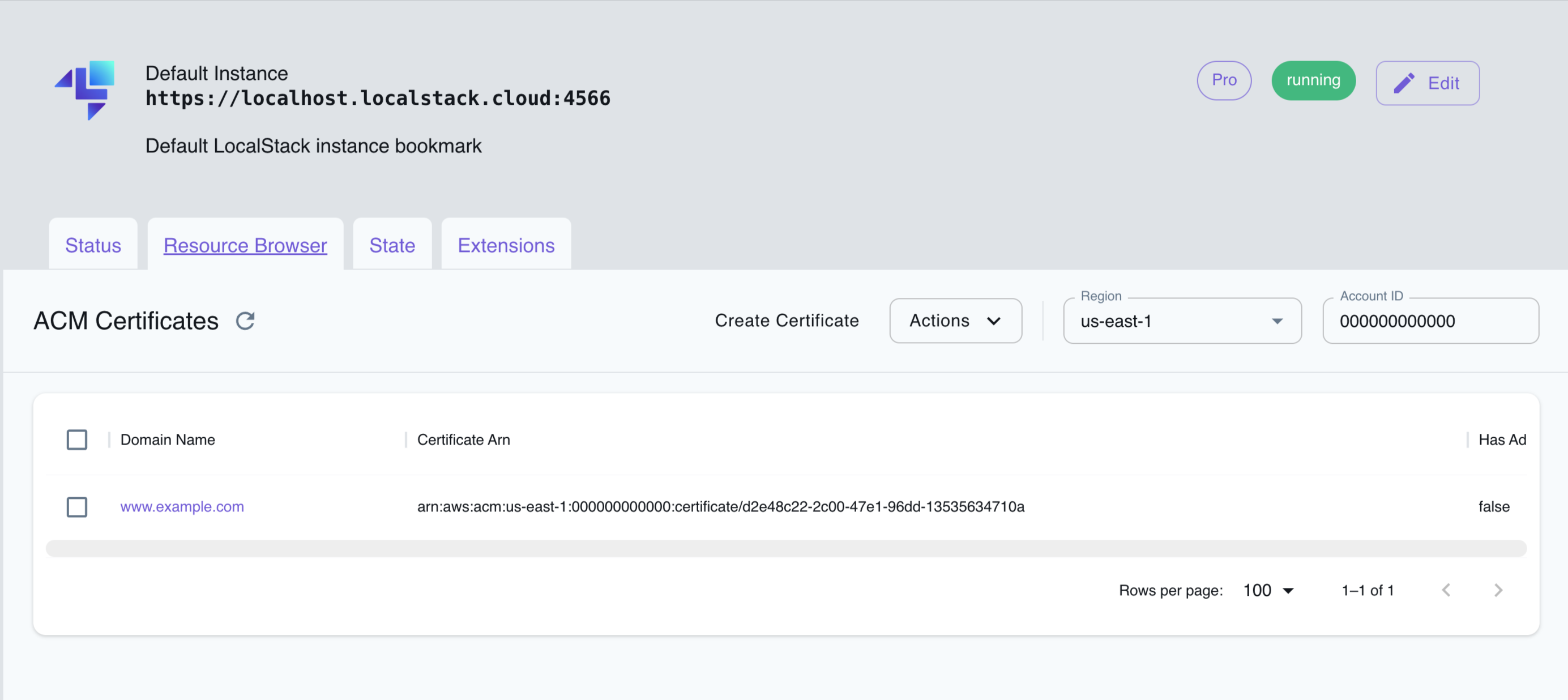Certificate Manager (ACM)
Introduction
Section titled “Introduction”AWS Certificate Manager (ACM) is a service that enables you to create and manage SSL/TLS certificates that can be used to secure your applications and resources in AWS. You can use ACM to provision and deploy public or private certificates trusted by browsers and other clients.
ACM supports securing multiple domain names and subdomains and can create wildcard SSL certificates to protect an entire domain and its subdomains. You can also use ACM to import certificates from third-party certificate authorities or to generate private certificates for internal use.
LocalStack allows you to use the ACM APIs to create, list, and delete certificates. The supported APIs are available on our API Coverage section, which provides information on the extent of ACM’s integration with LocalStack.
Getting started
Section titled “Getting started”This guide is designed for users who are new to ACM and assumes basic knowledge of the AWS CLI and our awslocal wrapper script.
Request a public certificate
Section titled “Request a public certificate”Start your LocalStack container using your preferred method, then use the RequestCertificate API to request a new public ACM certificate. Specify the domain name you want to request the certificate for, and any additional options you need. Here’s an example command:
awslocal acm request-certificate \ --domain-name www.example.com \ --validation-method DNS \ --idempotency-token 1234 \ --options CertificateTransparencyLoggingPreference=DISABLEDThis command will return the Amazon Resource Name (ARN) of the new certificate, which you can use in other ACM commands.
{ "CertificateArn": "arn:aws:acm:<region>:000000000000:certificate/<certificate_ID>"}List the certificates
Section titled “List the certificates”Use the ListCertificates API to list all the certificates.
This command returns a list of the ARNs of all the certificates that have been requested or imported into ACM.
Here’s an example command:
awslocal acm list-certificates --max-items 10Describe the certificate
Section titled “Describe the certificate”Use the DescribeCertificate API to view the details of a specific certificate.
Provide the ARN of the certificate you want to view, and this command will return information about the certificate’s status, domain name, and other attributes.
Here’s an example command:
awslocal acm describe-certificate --certificate-arn arn:aws:acm:<region>:account:certificate/<certificate_ID>Delete the certificate
Section titled “Delete the certificate”Finally you can use the DeleteCertificate API to delete a certificate from ACM, by passing the ARN of the certificate you want to delete.
Here’s an example command:
awslocal acm delete-certificate --certificate-arn arn:aws:acm:<region>:account:certificate/<certificate_ID>Resource Browser
Section titled “Resource Browser”The LocalStack Web Application provides a Resource Browser for managing ACM Certificates. You can access the Resource Browser by opening the LocalStack Web Application in your browser, navigating to the Resource Browser section, and then clicking on Certificate Manager under the Security Identity Compliance section.

The Resource Browser allows you to perform the following actions:
- Create Certificate: Create a new ACM certificate by clicking Create Certificate and providing the required information.
- View Certificate: View the details of a specific certificate by clicking on the domain name.
- Delete Certificate: Delete a certificate by selecting the certificate, followed by clicking Actions and then Remove Selected.
Examples
Section titled “Examples”The following code snippets and sample applications provide practical examples of how to use ACM in LocalStack for various use cases:
API Coverage
Section titled “API Coverage”| Operation ▲ | Implemented ▼ | Image | Verified on Kubernetes |
|---|